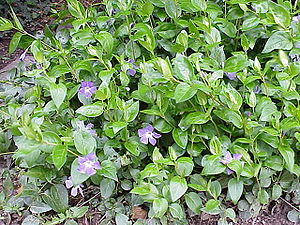Vinca
| Vinca | |
|---|---|
 | |
| Genus: | Vinca |
| Family: | Apocynaceae |
| Type: | Perennials |
| Pollination: | Insects |
| Toxicity and edibility: | Toxic if eaten. |
Vinca is a genus of five species of in the family Apocynaceae, native to Europe, northwest Africa and southwest Asia. The common name, shared with the related genus Catharanthus, is Periwinkle.[1]
Description
editThey are trailing vines, subshrubs or herbaceous, and have slender trailing stems 1-2 m [2] long but not growing more than 20-70 cm [3] above ground; the stems frequently take root where they touch the ground, enabling the plant to spread widely. The leaves are opposite, simple broad lanceolate to ovate, 1-9 cm [4] long and 0.5-6 cm [5] broad; they are evergreen in four species, but deciduous in the herbaceous V. herbacea, which dies back to the root system in winter.
The flowers, produced through most of the year, are salverform (like those of Phlox), simple, 2.5-7 cm [6] broad, with five usually violet (occasionally white) petals joined together at the base to form a tube. The fruit consists of a group of divergent follicles; a dry fruit which is dehiscent along one rupture site in order to release seeds.
Species
editThe two most commonly grown species are Vinca major and Vinca minor
Uses
editTwo species, the Small Periwinkle V. minor and the Large Periwinkle V. major, are very popular ornamental plants in gardens, grown for dense evergreen ground cover and their delicate violet flowers. V. major has broader leaves with a hairy margin and larger flowers, is less cold hardy, and has twice as many chromosomes as V. minor. A variegated selection of V. major is commonly cultivated. Both species are considered invasive weeds in parts of the United States and Australia. They do not respond to common herbicides and require hormone based sprays to control.
This plant was formerly used in homeopathy for catarrh and dyspepsia but due to the nature and effects of the alkaloids vincamine, isovincamine and vincamidine, it is rarely used. The chemotherapy drugs vincristine and vinblastine are derived from this plant.[1]
Maintenance
editRemove any leaf cover in the fall to prevent fungal problems.
Propagation
editPropagated by cuttings.
Pests and diseases
edit- Phoma exigua var. exigua (asexual stage Diaporthe vincae)
- Alternaria
- Colletotrichum
- Macrophoma vincae
- Phyllosticta
- Phyllosticta minor
- Phyllosticta vincae-majoris
- Green Peach Aphid: Myzus persicae
- Oleander Aphid: Aphis nerii
- Crescent-marked Lily Aphid: Neomyzus circumflexus
- Brown Soft Scale: Coccus hesperidum
- Aster Leafhopper: Macrosteles facifrons
- Silverleaf Whitefly: Bemisia argentifolii
- Citrus Mealybug: Planococcus citri
- European Earwig: Forficula auricularia
- Flower thrips: Frankliniella thricti
Gallery
edit-
Large Periwinkle (Vinca major) flower
-
Vinca minor (above), Vinca major (below); leaves for comparison
-
Vinca minor (above), Vinca major (below); leaf margins for comparison; note hairless margin of V. minor, hairy margin of V. major
References
edit- ↑ Jump up to: a b Pharmacognosy of Vinca (Periwinkle)
- ↑ 3-6 feet
- ↑ 8-30 inches
- ↑ 1/4-3.5 inches
- ↑ 1/4-2.25 inches
- ↑ 1-3 inches
- Flora Europaea: Vinca
- Virtual Flowers Vinca
- Blamey, M., & Grey-Wilson, C. (1989). Flora of Britain and Northern Europe. Hodder & Stoughton.
- Huxley, A., ed. (1992). New RHS Dictionary of Gardening 4: 664-665. Macmillan.
- Pirone, Pascal P. (1978). Diseases & Pests of Ornamental Plants (Fifth Edition ed.). John Wiley & Sons, New York. pp. 530–531.
{{cite book}}:|edition=has extra text (help); Cite has empty unknown parameter:|coauthors=(help) - Cranshaw, Whitney (2004). Garden Insects of North America: The Ultimate Guide to Backyard Bugs. Princeton University Press. p. 625.
{{cite book}}: Cite has empty unknown parameter:|coauthors=(help)